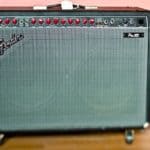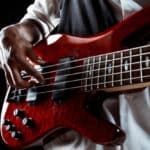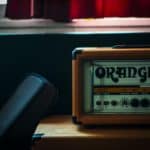You wouldn’t want to plug your guitar into an amp and cause any damage, so you’d rightfully be wondering if all electric guitars are compatible with all amps. And to put it simply:
Any electric guitar brand or type will work with any amp brand or type, furthermore, you can even plug your electric guitar into a bass amp and it will work fine, however, the sound you get will not be the best. This is also valid for acoustic guitar amps or any other kind of powered speaker.
The main thing that changes when you plug your guitar into different amps is the tone. There are some standards of what is acceptable based on cultural preferences around different guitar sounds, but ultimately, it’s subjective.
Are guitar amps universal?
Yes, all or at least 99 percent of guitars have compatible outputs to the standard amp. The standard is a ¼” high-impedance connector between the output on the guitar and the input on the amp. You’re unlikely to find variances on that.
Despite their appearance, amps are quite simple in their basic makeup. Tube amps have been around for more than a century, and they’re usually the standard of quality.
They provide a superior sound without much need for extra gadgets. Most amps nowadays include tone stacks that allow you to play with the output of different sound ranges and some come with an overdrive button, but those aren’t dependent on your guitar’s input type.
Why are there that many different guitar amps then?
It’s all about different tones. There are four main types of guitar amps: Tube, Solid State, Modelling, and Hybrids. Each of these amps uses different technology to produce its tones.
Usually, the sought-after aspect here is quality and trusted brands. Fender, Orange, and Vox are well-known brands that are associated with good tone and even with famous guitar players.
Tube (or Valve) amps
With these amps, the sound is produced by a vacuum tube within the amp that becomes hot when you crank up the sound, which breaks up your guitar signal and provides a smooth overdrive effect.
Solid-state amps
These use a transistor instead of a vacuum tube to produce tones. What’s great about this is that they’re much more lightweight and way less fragile than tube amps. They’re a lot more consistent in tone too, which is a pro or a con depending on who you ask.
Modeling amps
The next evolution after Solid-state amps. They’ve mostly overtaken solid-state amps because of the technology involved. Modeling amps are digital amps that mimic the sound tone of well-known amps.
They’re extremely versatile in that you’re able to switch between many different tones on just one amp. When the technology first came out, the digital imitation was noticeably bad, but with time, they’ve advanced enough that their sound is almost indistinguishable from older tech amps.
Hybrid Amps
These amps are a mixture between tube amps and modeling amps. They’re meant to give the best of both worlds between a tube amp and a modeling amp, but they’re usually disappointing.
Hybrid amps are usually a compromise between two amp types but none of the hybrid parts are completely as good as the amps they’re standing in for. This makes them unpopular among most guitar players.
So what’s the difference?
Each amp type comes with its set of pros and cons:
Pros
| Tube/Valve | Solid State | Modeling | Hybrid |
| Simple to use Known for great tone | Tone is clean and clear Lighter than tube amps Relatively cheap | Huge variety of tones Even lighter than Solid State amps Far cheaper than other amp types, while still maintaining quality | Makes use of tube amps for a more authentic sound than modeling amps Has a wider range of tones than a tube amp |
Cons
| Tube/Valve | Solid State | Modeling | Hybrid |
| Heavy Fragile Expensive Tone is usually only good at high volumes Limited tonal variety | Tone can seem cold and dead compared to tube amps Also has limited tone variety | Older models don’t sound good Some people consider the digital aspect fake sound | Heavier than modeling amps More expensive than modeling amps The tone difference is a con for some |
Do some amps work better with certain guitars?
All guitars work with all amps, but some pairings do typically sound better together.
Gibson and Marshall are a match made in heaven for rock ‘n rollers. The Gibson’s humbuckers provide a thick, rich tone that pairs beautifully with the Marshall’s saturated sounds.
This combo is often the benchmark tone that other rock tones are compared to, mostly because famous players like Slash, Angus Young, and the likes are best known for playing. A lot of it is nostalgia, but it’s well-earned nostalgia.
PRS and Mesa are great pairings for the modern metal/ hard rock sound. It was the combo of choice for many early 2000s band guitar players such as Mark Tremonti (Creed) and Brad Delson (Linkin Park).
The PRS’ Humbuckers merge well with the Mesa amp heads, but they’re not just for metal bands. Carlos Santana is one of the earliest proponents of this combo and has used it since the 80s to get the unique guitar tone that he’s so famous for.
Fender basically built their amps to pair with their guitars. The thin, clear tones of Fender single-coil pickups are complemented by the high headroom provided by their tube amps.
You can safely crank your Fender amp up without having to worry about any signal break up at high volumes while also maintaining the clean tone of the guitar. This allows a great dynamic range and a broad frequency response for players.
This pairing has been used by great players too, such as Stevie Ray Vaughan and Eric Johnson.
How to know what guitar and amps go well together?
The best way to know is to try different combos over time. You can save yourself the effort by doing a little bit of research though.
Start by looking into which pairings your favorite guitar players use and see if you can get the same or a similar setup.
Ultimately, every guitar player has their preferences, and amp and guitar pairings are a subjective topic. If you take someone’s advice on which pair to get as universal, you might just wind up limiting yourself.
My best advice is to ask yourself what sound you desire and what your playing style is, and then see if you can find well-known pairings that match that.
You could also try getting a good Modelling amp, this will give you the variety necessary to explore your own preferences.
What about amps intended for other instruments?
There are a couple of other amp variations you can try out.
Electric bass guitars obviously have bass amps. These amps are more suited to the low frequencies of the thicker strings. It’s possible to play a bass guitar on a standard guitar amp, but it’s not a great pairing and you may even risk damaging your amp.
Acoustic amps are another derivative of electric amplifiers. These amps are designed to work with the clean and clear signal of an acoustic instrument. It’s mainly meant to amplify the volume and doesn’t focus on effects like an electric guitar amp would.
Lastly, you can even hook your guitar up to stereo amplifiers. If you have the right input jack, you can play your guitar through your home speaker system. You won’t get any effects or overdrive though, just the clean tone of your guitar.

Hello there, my name is Ramiro and I’ve been playing guitar for almost 20 years. I’m obsessed with everything gear-related and I thought it might be worth sharing it. From guitars, pedals, amps, and synths to studio gear and production tips, I hope you find what I post here useful, and I’ll try my best to keep it entertaining also.





